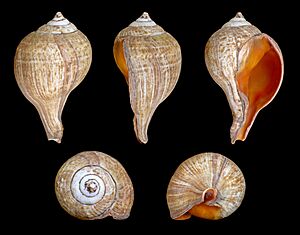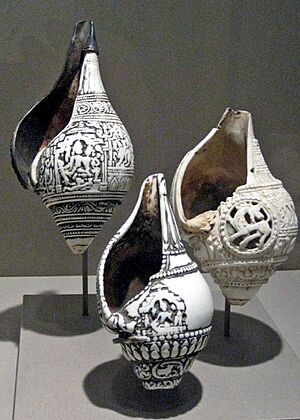Turbinella pyrum facts for kids
Quick facts for kids Turbinella pyrum |
|
|---|---|
 |
|
| Five views of a shell ofTurbinella pyrum with its periostracum intact | |
 |
|
| Three carved dextral shells of Turbinella pyrum from 11th century India, see shankha | |
| Scientific classification | |
| Synonyms | |
|
Buccinella caerulea Perry, 1811 |
The chank shell (scientific name: Turbinella pyrum) is a very large sea snail. People also call it the sacred chank or just chank. Sometimes, it's known as the divine conch or simply a conch. This amazing creature lives in the Indian Ocean.
It's a type of mollusk that has a gill (like a fish's breathing organ) and an operculum. An operculum is a little "door" that closes the shell opening. The word "chank" comes from the Indian word shankha, which means "divine conch."
Contents
Where Do Chank Shells Live?
This special sea snail is found mainly in the warm waters of the Indian Ocean.
What Does a Chank Shell Look Like?
The shell of the chank snail is very big and strong. It usually has three or four clear folds inside, near the center.
Most of the time, the shell is pure white. It's covered by a thick brown layer called a periostracum. This layer is like a protective skin. Sometimes, the shell can also be a light apricot color. You might even see some shells with dark brown spots.
How People Use Chank Shells

Chank shells are very important in some religions, especially Hinduism and Buddhism. They are seen as sacred symbols. In these religions, the chank shell is one of the eight auspicious symbols.
Sometimes, the tip of the shell is cut off. This allows it to be blown like a ceremonial trumpet. These special shells are often decorated with metal and shiny stones.
Right-Handed and Left-Handed Shells
Most snail shells, including the chank shell, coil in a "right-handed" way. This is called dextral coiling. But very, very rarely, you can find a chank shell that coils in a "left-handed" way. This is called sinistral coiling. It's so rare that only about 1 in 200,000 chank shells are left-handed!
In Hinduism, these rare left-handed shells are called Dakshinavarti Shankh. The more common right-handed shells are called Vamavarti. The Dakshinavarti shells are considered much more valuable and have a very special religious meaning.
It's interesting to know that how scientists measure "handedness" is different from how it's seen in religion. Scientists look at the shell in one way, but for religious purposes, the "spout" of the shell is pointed upwards to decide if it's right-handed or left-handed.
Images for kids



